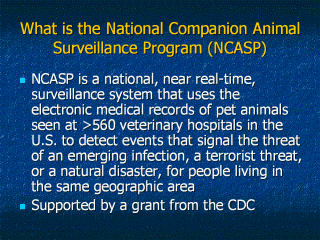| front |1 |2 |3 |4 |5 |6 |7 |8 |9 |10 |11 |12 |13 |14 |15 |16 |17 |18 |19 |20 |21 |22 |23 |24 |25 |26 |27 |28 |29 |30 |31 |32 |33 |review |
 |
· A companion animal
surveillance system designed to signal disease threats to humans is not
intended to replace existing human surveillance at the local, state, or
national, level, but rather to complement human surveillance systems. · Complementary human and animal surveillance requires good communication between physicians and veterinarians · Alerts raised through health surveillance of people are often false alarms (false positives). When human and animal surveillance is conducted in parallel, alerts raised by both systems at the same time are less likely to be the result of a false positives finding (i.e., improved positive predictive value). |